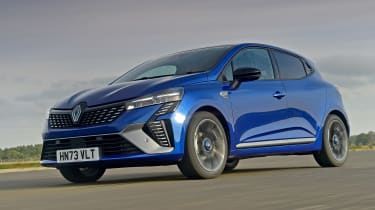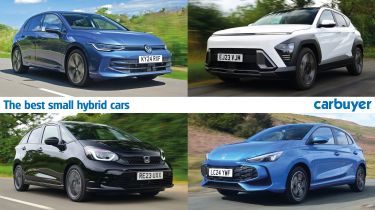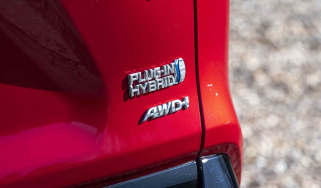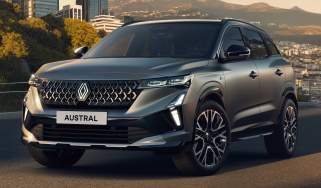Renault Clio review - E-Tech hybrid takes on EV rivals


A small hybrid car might just be your best bet if you’re looking to cut your fuel bill without spending a fortune. The economy-boosting tech has found its way into many small hatchbacks and SUVs in recent years, making them ideal low-cost urban runarounds.
If you’re looking to buy a small hybrid car, you’ll first need to consider which type of hybrid is the right one for you. Yes, there’s more than just one type of hybrid these days – you’ve got mild hybrids, self-charging hybrids and plug-in hybrids to contend with. Mild hybrids offer the least electrical assistance and usually don’t allow for any electric-only driving, so we’ve ignored them for this list.
 The best small cars and superminis in 2025
The best small cars and superminis in 2025
That leaves self-charging and plug-in hybrids to pick from. Self-charging hybrids were the first on the scene – think of cars like the original Toyota Prius. They use a small battery and, as the name suggests, recharge automatically through normal driving. It’s the most common hybrid system found in small cars, and can bring substantial fuel economy improvements for not much extra cash over a traditional petrol car.
Plug-in hybrids are generally more expensive, as they use a bigger battery and can be recharged through an external source. The pay-off is a much longer electric-only driving range, sometimes exceeding 60 miles. That’ll be enough to cover most drivers’ commutes, so they can bring enormous fuel savings.
However, they’re only really useful if you can regularly keep the battery topped up. Without access to a home charger, you might find yourself lugging around a heavy, empty battery, which will tank your fuel economy. If you can access a home charger and mainly stick to urban driving, a small electric car could be worth considering, too. They’re far more affordable than they were a few years ago – we’ve covered the cheapest electric cars you can buy today.
If it’s a hybrid you’re after, these are the small cars to consider. We’ve mentioned whether they’re self-charging or plug-in, and the stated price is for the most affordable hybrid version.
The Renault Clio E-Tech is a great-value hybrid hatch that punches above its weight. It’s powered by a 1.6-litre petrol engine which is linked to two electric motors and a 1.2kWh lithium-ion battery. The energy the car harvests when slowing down (known as regenerative braking) is stored in the battery and used to drive the car on pure electric power at speeds up to 40mph. Thanks to this electric assistance, official fuel economy stands at 67mpg, which is better than many modern diesel cars.
It’s quite a complicated self-charging hybrid system that can feel rather restless when power is shuffled between the petrol engine and electric motor. But on our test drive, the car spent most of its time in electric mode, which is promising for fuel consumption – it certainly runs on electric power more often than the Toyota Yaris Hybrid. Taking into account the Clio’s impressive hybrid system, classy cabin and great driving experience, we crowned it Best Small Car at the 2025 Carbuyer Best Car Awards.
| Pros | Cons |
|
|
We love a bargain here at Carbuyer, and you’ll struggle to find a better one today than the Dacia Duster. The rugged, small SUV costs from just under £19,000, but even the self-charging hybrid model can be had for just over £24,000. That’s less than many of the hatchbacks on this list, yet the Duster packs space for the whole family and a host of useful SUV features.
With its raised ride height, you have a commanding view of the road from the driver’s seat, but the Duster is still pretty enjoyable to drive. That’s thanks to its Renault Clio-based underpinnings – it shares many of its suspension components, not to mention its engine and self-charging hybrid system. It’s not quite as efficient in the Duster, but 56mpg is nothing to be sniffed at for a small SUV. Sure, poke around some of the interior plastics and you’ll quickly spot where Dacia has cut corners, but at least the tech is up to scratch and miles ahead of the old Duster.
| Pros | Cons |
|
|
The rejuvenated MG brand has taken the UK by storm with its range of affordable cars, but the MG3 is one of its most impressive yet. Unlike the fully electric MG4 hatchback, the MG3 uses a self-charging hybrid system, combining a 1.5-litre petrol engine with a 1.83kWh battery and an electric motor. Not only is it efficient – returning up to 64mpg – but it’s quick, too. All in, the system puts out 192bhp, making for some nippy acceleration.
What really solidifies the MG3 near the top of this list is the value-for-money it offers. Starting from well under £20,000, other small hybrid cars don’t come close. You get the same efficiency figures as pricier hybrid hatchbacks on this list, but with more power and more standard kit. Sure, feel around the cabin and you’ll find some scratchy plastics, and the boot isn’t particularly big, but we can forgive these shortcomings. As a bonus, all MGs get a seven-year, 80,000-mile warranty, which is better than many rivals.
| Pros | Cons |
|
|
The Hyundai Kona is one of our favourite small SUVs, even more so when fitted with the self-charging hybrid engine. It may not be as affordable to buy as some smaller hybrid superminis, but its running costs are just as low; the 1.6-litre petrol engine and electric motor combine to return 60mpg, but you can expect even more than that if you mainly stick to low speed urban driving. Which you’ll probably want to do, as the Kona isn’t particularly fast – its 12-second 0-62mph time feels particularly leisurely compared to some rivals.
However, we can’t argue with the comfort on offer in the Kona. Having a higher ride height compared to most hatchbacks gives the Kona more suspension travel, allowing it to soak up bumps in the road with ease. Many drivers will appreciate the light controls which are easy to modulate, and the outward visibility is excellent. Throw in a fantastic interior, and you’re onto a small hybrid car winner.
| Pros | Cons |
|
|
Toyota has a stellar reputation for its pioneering hybrid technology, and the Corolla builds on the firm's strong record for selling hybrid cars that represent great value for money. We can’t say that the Corolla has the most exciting driving experience, but it has eye-catching styling, a good reliability record and diesel-beating efficiency.
Both the 1.8-litre and 2.0-litre hybrid powertrains return over 60mpg, and the Corolla will be around £1,500 cheaper annually for company-car drivers than a petrol Ford Focus or Vauxhall Astra. Even the entry-level model includes LED headlights and a reversing camera, and you get the best warranty in the business, extending to 10 years and 100,000 miles when serviced at an official dealer.
The Toyota’s spot on this list is further solidified by the brand’s impressive Driver Power owner’s survey performance. The Japanese marque came eighth out of 32 manufacturers, with reliability and running costs earning it high praise from owners.
| Pros | Cons |
|
|
Given that the Kia Niro is essentially the same car as the Hyundai Kona underneath, it’s no surprise that it also found its way onto this list. The Niro wears more conventional styling than its sister car, but it still delivers low running costs and a spacious interior – attributes that contributed to its first place in our Carbuyer Best Car Awards 2023.
Unlike most cars that are offered as either an EV or a petrol-only model, the Niro has three separate electrified powertrains to choose from to suit all budgets. The standard Niro Hybrid has a self-charging powertrain that returns 59.8mpg. The PHEV model costs £5,000 more, but it can achieve 40 miles of zero-emissions driving from a charge, cutting overall running costs.
No matter which Niro fits your budget, they all have impressive technology, and we think the ‘3’ trim strikes the best balance between price and equipment. However, those looking at the PHEV may want to check if the boot is big enough for their needs, as it’s smaller than the cargo space in the EV and Hybrid.
| Pros | Cons |
|
|
The original Renault Captur, like the Nissan Juke, helped popularise the small SUV class. Its spacious cabin coupled with generous boot space tempted families out of their hatchbacks and into SUVs with a taller ride height and better practicality. Now in its second generation, the Captur has grown in size, features a striking new design and benefits from even lower running costs, thanks to the hybrid E-Tech version.
The self-charging hybrid system is identical to the one found in the Clio hatchback and combines a 1.6-litre petrol engine with an electric motor and a small battery. It’s the most powerful Captur you can buy, with a power output of 143bhp, while fuel economy stands at 60mpg. That’s slightly down on the Clio hatchback, but it’ll be a worthwhile trade-off for some with the added practicality and raised ride height of an SUV.
Like the Clio, the Captur’s automatic gearbox shifts through gears smoothly but there is a notable transition between petrol and electric power. On the plus side, it gets the same cabin as the Clio, which is pleasantly premium-feeling for a car of this price.
| Pros | Cons |
|
|
It may be the priciest car on this list, but the Volkswagen Golf delivers a polished driving experience, a premium cabin and a cutting edge plug-in hybrid powertrain. Following a 2024 facelift, the Golf eHybrid uses a 1.5-litre petrol engine alongside a large 19.7kWh battery. That’s nearly the same size as the battery fitted to the original Nissan Leaf EV, and as a result, the Golf can travel up to 88 miles on electric power alone – more than most PHEVs on sale today.
Like every Golf gone before it, the latest model is more than capable of managing family life, with roomy rear seats and plenty of safety kit. Unfortunately, the big battery eats into boot space, so there’s only 273 litres on offer – less than the Yaris supermini – but at least you get plenty of standard equipment.
| Pros | Cons |
|
|
Costing from just £22,000, the MG ZS is currently the most affordable hybrid SUV you can buy. It’s essentially a slightly bigger and taller version of the MG3 hatchback above, a recipe that we think will appeal to lots of families looking for value, space and efficiency. This is still a small SUV, though, so it’ll be easy to park and drive around town.
On paper, there’s very little to fault about the MG ZS. It has space for five passengers, a big boot, it returns up to 55mpg and will hit 0-62mph in under nine seconds. One reason to pick the ZS over the MG3 is the added space up front – taller drivers will fit more comfortably here. On the road, it doesn’t feel quite as polished as the Renault Captur, with some noticeable wind and road noise once you’re up to speed. MG also hasn’t been the most reliable manufacturer in our Driver Power owner’s surveys, but at least it comes with an impressive seven-year warranty.
| Pros | Cons |
|
|
The Honda Jazz impressed us with its smooth driving characteristics and technology. It now gets Android Auto and Apple Carplay smartphone connectivity as standard, and if you go for the SR model you’ll get to enjoy them on a nine-inch touchscreen. The small car from Honda has had a loyal customer following for decades, thanks to its versatile cabin and low running costs. The clever e:HEV self-charging hybrid system reduces fuel consumption to 61.4mpg, but the Jazz is no longer the cheapest car in its class – a starting price of nearly £27,000 is considerably more than the MG3 and Renault Clio .
Boot space isn’t class-leading, although the raised position for driver and passengers makes it easier to get in and out. We would stick with the standard wheels, as the larger optional alloy wheels make the ride less comfortable. At low speeds the Jazz feels similar to driving an electric car, but you’ll have the ability to refill the petrol tank in minutes, meaning fewer compromises.
| Pros | Cons |
|
|
Below you’ll find a full table of the best small hybrid cars with their price and Carbuyer score.
| Best small hybrid car ranking | Make and model | Priced from | Carbuyer rating (out of 5) |
| 1 | Renault Clio | £22,000 | 4.4 |
| 2 | Dacia Duster | £24,000 | 4.2 |
| 3 | MG3 | £18,000 | 4 |
| 4 | Hyundai Kona | £30,000 | 4.3 |
| 5 | Toyota Corolla | £31,000 | 4.3 |
| 6 | Kia Niro | £30,000 | 4.3 |
| 7 | Renault Captur | £25,000 | 4.3 |
| 8 | Volkswagen Golf | £36,000 | 4.1 |
| 9 | MG ZS | £22,000 | 4.1 |
| 10 | Honda Jazz | £27,000 | 4.1 |
Our expert road testers have a lot to consider when weighing up the best small hybrid cars. They drive every model available on the market, often testing them back to back with direct rivals.
The cars that stand out have to perform well across a mixture of scenarios, be it around town, on a B road or on the motorway. Hybrid car buyers are looking for great fuel economy, so this is something we make sure to take note of during our testing. A good hybrid system should be smooth when switching between petrol and electric power, and offer enough of an electric-only driving range to be useful around town.
A high-scoring hybrid should return a big enough fuel economy improvement over a petrol model to make the extra outlay worthwhile. While price isn’t something we directly score a car on, we’re always on the lookout for models that represent excellent value. Some small hybrid cars today actually cost less than their petrol rivals, which can make it easier to forgive their drawbacks.
Then there are the usual criteria that apply to all small cars. Is it easy to drive around town? Does the interior feel cramped or low quality? How big is the boot? Does it feel out of its depth on the motorway? These are the things that matter to small car buyers, so they are high up our priority list when testing.
Visit our sister site Auto Express for an alternative view on the best small hybrid cars...
Don’t need a hybrid? Find out about the best small cars and superminis on sale…




